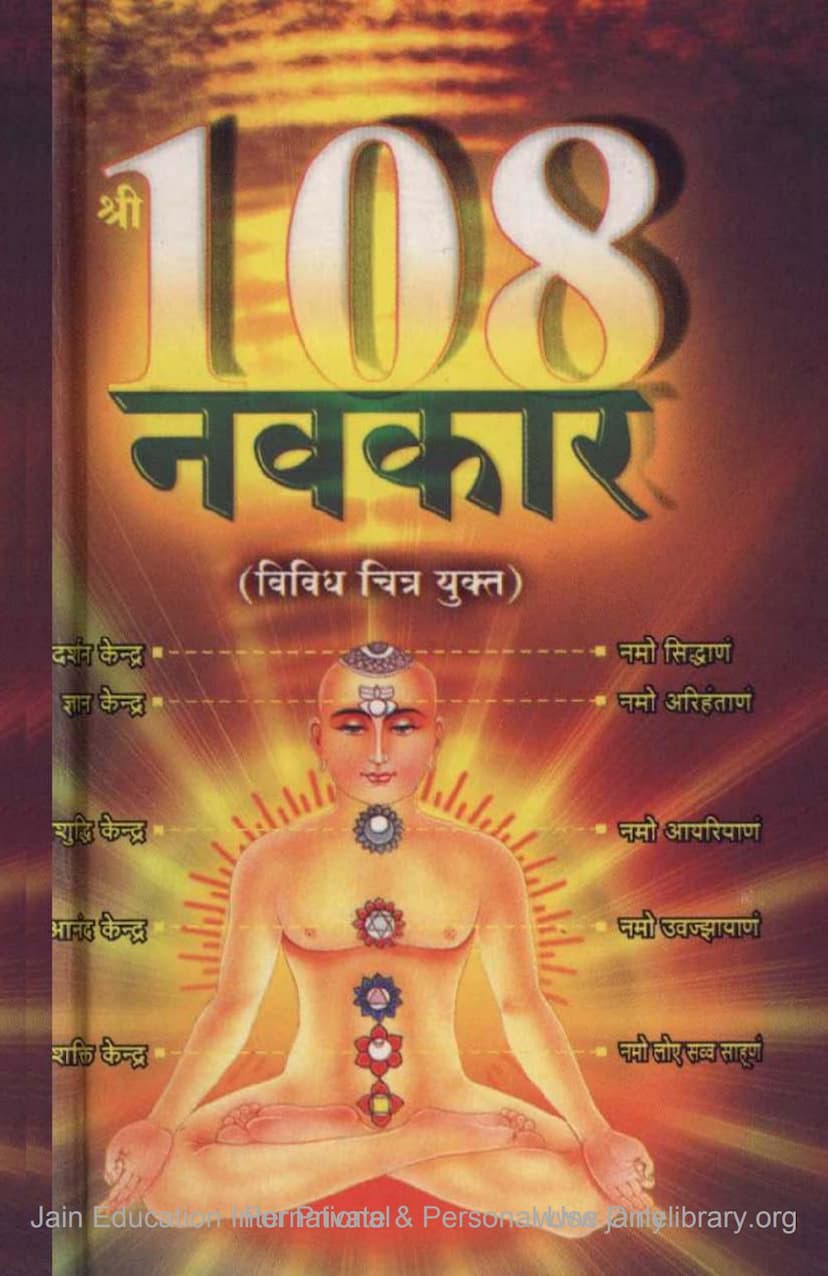Shri 108 Navkar
Added to library: September 2, 2025

Summary
Here's a comprehensive summary of the Jain text "Shri 108 Navkar" by Abhayshekharsuri, published by Arham Parivar Trust, based on the provided pages:
Overview:
"Shri 108 Navkar" is a devotional book focused on the Navkar Mantra, the most sacred and foundational mantra in Jainism. The book, presented in Gujarati and featuring various illustrations, aims to explain and promote the significance and power of this mantra. It emphasizes the mantra's role in spiritual advancement, protection, and the attainment of ultimate liberation.
Key Themes and Content:
- The Navkar Mantra as the Essence of All Scriptures: Page 4 explicitly states that the Navkar Mantra is the "essence of the fourteen Purvas" ( चौद पूरवनो सार) and its meaning is "infinite and immeasurable" (अर्थ अनंत अपार). This highlights its supreme importance in Jain philosophy, encapsulating all essential teachings.
- Universality and Timelessness: The mantra is described as being chanted by yogis, householders, kings, and even celestial beings and demons (Page 4: योगी समरे भोगी समरे, समरे राजा रंक; देवो समरे दानव समरे). It is also presented as having no beginning or end, making it eternal and relevant for all times and all beings (Page 7: नथी आरंभ नथी अंत!).
- The Five Supreme Beings (Panch Parmeshthi): The core of the Navkar Mantra is the salutation to the Panch Parmeshthi:
- Arihanta: Those who have conquered their inner enemies and are liberated.
- Siddha: Souls who have attained eternal liberation and omniscience.
- Acharya: Spiritual leaders and guides.
- Upadhyaya: Teachers of scriptures and spiritual knowledge.
- Sadhu: Ascetics and monks who follow the path of liberation.
- Spiritual Efficacy and Protection: The book repeatedly emphasizes the mantra's power to:
- Destroy Sins: It is called "the destroyer of all sins" (सव्व पावप्पणासणी) on multiple pages.
- Bestow Auspiciousness: It is considered the greatest of all auspicious things (मंगलाणं च सव्वेसिं पढम हवइ मंगलं).
- Grant Happiness and Remove Suffering: Chanting it brings happiness and alleviates worldly suffering (Page 4: सुखमां समरो दुःखमां समरो, भवभवना दुःख कापे).
- Provide Protection: Page 126 mentions it as a "shield" (वज्र-पञ्जराभं) for self-protection.
- Attain Liberation (Moksha): It is the mantra that leads to omniscience and liberation (Page 128: केवलज्ञान-मंत्र मंत्रं श्री जैनमंत्र जप जप जपितं जन्म निर्वाण मंत्रम्).
- The Structure and Components:
- Sixty-Eight Letters: The mantra is composed of 68 letters (Page 4: अडसठ अक्षर ओना जाणो).
- Eightfold Auspiciousness: It is associated with eight types of prosperity (Page 4: आठ संपदाथी परमाणो).
- Ninefold Wealth: It grants the nine treasures associated with the nine supreme entities (Page 4: नवपद ओना नवनिधि आपे).
- Methods of Chanting (Jap): Page 8 outlines different ways to chant the mantra:
- Bahya Jap (External Chanting): Spoken aloud so others can hear.
- Upanshu Jap (Whispered Chanting): Chanted with moving lips but no audible sound.
- Manas Jap (Mental Chanting): Chanted silently in the mind, without moving lips.
- Ajapa Jap (Unspoken Chanting): Effortless, natural chanting.
- It also suggests maintaining consistency in direction, posture, time, and the mala used for increased benefit.
- Illustrative Stories: Several pages (120-125) feature short narratives illustrating the power of the Navkar Mantra in past lives. These stories depict how reciting or hearing the mantra brought about positive transformations, such as:
- A Bhil couple becoming king and queen in their next life.
- Shivkumar Yogi obtaining children and a golden man through the mantra.
- A snake's garland turning into a real garland, and a woman's husband becoming religious.
- A prostitute's recitation leading a thief to rebirth as a prince.
- Jinadatt Seth being saved from a king's wrath due to the mantra.
- Invocation and Dedication: The book begins with salutations to spiritual lineage (Page 6) and includes a prayer for universal well-being at the start of chanting (Page 11: शिवमस्तु सर्व जगतः). It also offers an apology (Michchhami Dukkadam) for any errors (Page 7).
- Visual Presentation: The book is rich with illustrations, many of which are artistic representations of the Navkar Mantra itself, with the names of the Panch Parmeshthi creatively arranged. This visual element is intended to make the mantra more accessible and engaging.
- Publisher and Publication Details: The publisher is Arham Parivar Trust, and the publication year is Samvat 2062 (Mah Vada 6). The price is listed as Rs. 75/-.
In essence, "Shri 108 Navkar" serves as a devotional guide, celebrating the Navkar Mantra as the ultimate spiritual tool for purification, protection, and the eventual attainment of liberation in Jainism. It underscores the mantra's profound efficacy through its teachings, illustrative stories, and visual representations.